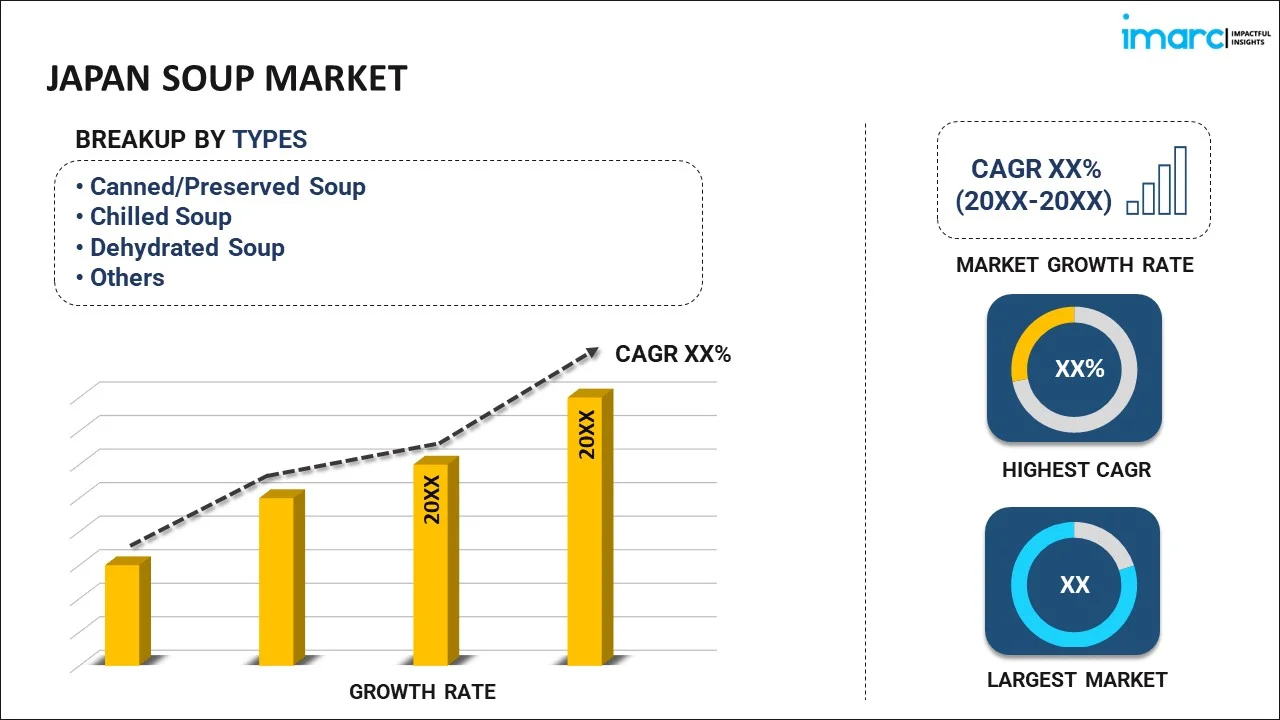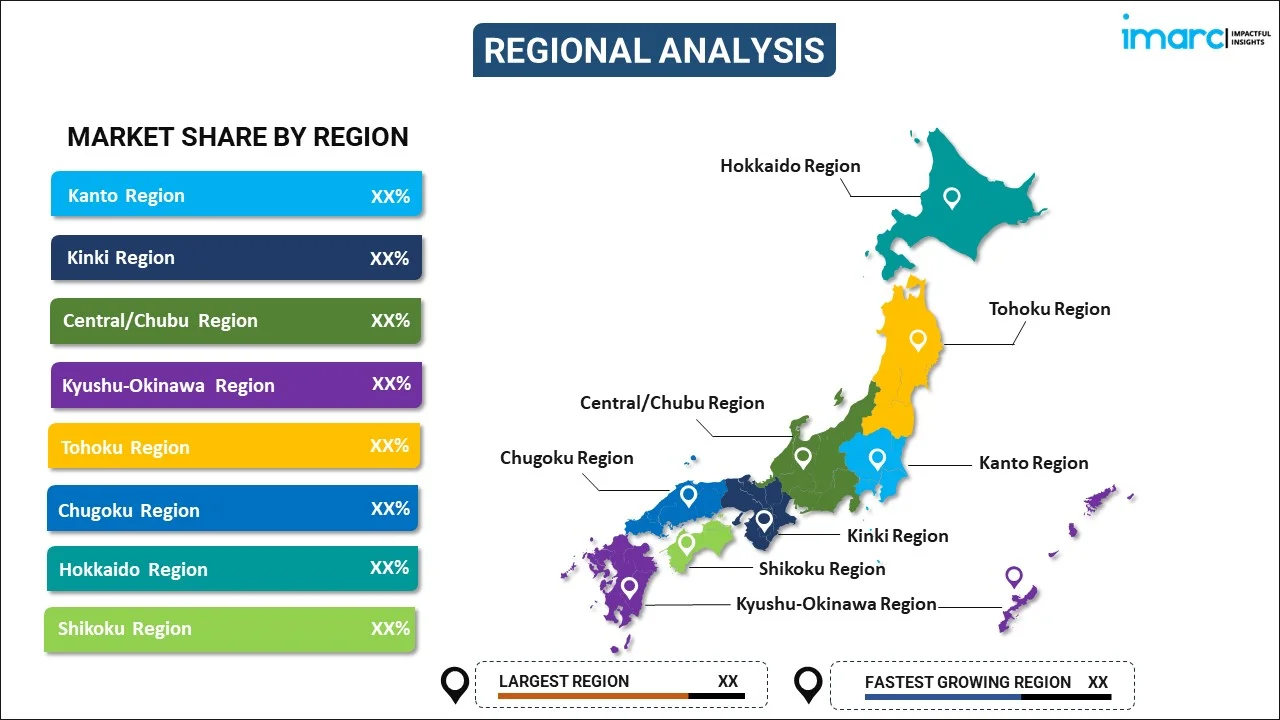
Japan Soup Market Report by Type (Canned/Preserved Soup, Chilled Soup, Dehydrated Soup, Frozen Soup, UHT Soup), Category (Vegetarian Soup, Non-Vegetarian Soup), Packaging (Canned, Pouched, and Others), Distribution Channel (Supermarkets and Hypermarkets, Convenience Stores, Online Stores, and Others), and Region 2025-2033
Market Overview:
The Japan soup market size reached USD 700 Million in 2024. Looking forward, IMARC Group expects the market to reach USD 900 Million by 2033, exhibiting a growth rate (CAGR) of 2.9% during 2025-2033. The rising consumption of convenient food products, increasing demand for healthier and natural food options, and the growing single person households represent some of the key factors driving the market.
|
Report Attribute
|
Key Statistics
|
|---|---|
|
Base Year
|
2024 |
|
Forecast Years
|
2025-2033 |
|
Historical Years
|
2019-2024
|
| Market Size in 2024 | USD 700 Million |
| Market Forecast in 2033 | USD 900 Million |
| Market Growth Rate (2025-2033) | 2.9% |
A soup is a liquid-based dish that helps maintain hydration levels, proper digestion and circulation, and overall bodily functions. It contains various vegetables, meats, legumes, and grains that provide a wide array of essential nutrients, such as vitamins, minerals, and fiber, which contribute to the health, support immune function, and promote optimal organ function. Its incorporation into a well-balanced diet supports weight management due to the high-water content and fiber in soups that create a feeling of fullness and prevent overeating. Besides this, soups made with ingredients like garlic, onions, herbs, and spices can provide immune-boosting benefits as these ingredients may possess antimicrobial and anti-inflammatory properties. Additionally, its warmth provides a soothing and comforting effect, especially during colder months and when recovering from illness or experiencing congestion. Furthermore, the versatility and nutritional value of soups make them a staple in Japanese households and restaurants.
Japan Soup Market Trends:
A considerable health consciousness among the Japanese population represents one of the key factors catalyzing the demand for nutritious and wholesome food options, like soup. Additionally, the increasing consumption of soups that are low in calories, rich in vitamins, and contain natural ingredients without additives or preservatives, is impelling the market growth in the country. Apart from this, busy schedules and the rise of single-person households are increasing the sales of ready-to-eat (RTE) and easy-to-prepare soup products. Along with this, consumers are looking for quick and convenient meal solutions that balance taste and nutrition, encouraging market players to develop instant, cup, and ready-to-serve soups. Furthermore, there is a growing interest in traditional and regional soup recipes, reflecting the cultural appreciation for authenticity and local flavors, which is offering a favorable market outlook. Moreover, dietary trends, such as vegetarianism, veganism, and gluten-free diets, are influencing the soup market in Japan. Manufacturers are currently introducing soups that cater to these specific dietary preferences, offering options free from animal products and gluten without compromising their taste and nutritional value. Besides this, the rise of online platforms in the country is offering a convenient way for consumers to explore and purchase different soup varieties, including specialty or niche products that may not be readily available in local stores.
Japan Soup Market Segmentation:
IMARC Group provides an analysis of the key trends in each segment of the Japan soup market report, along with forecasts from 2025-2033. Our report has categorized the market based on type, category, packaging, and distribution channel.
Type Insights:

- Canned/Preserved Soup
- Chilled Soup
- Dehydrated Soup
- Frozen Soup
- UHT Soup
The report has provided a detailed breakup and analysis of the market based on the type. This includes canned/preserved soup, chilled soup, dehydrated soup, frozen soup, and UHT soup.
Category Insights:
- Vegetarian Soup
- Non-Vegetarian Soup
A detailed breakup and analysis of the market based on the category has also been provided in the report. This includes vegetarian soup and non-vegetarian soup.
Packaging Insights:
- Canned
- Pouched
- Others
The report has provided a detailed breakup and analysis of the market based on the packaging. This includes canned, pouched, and others.
Distribution Channel Insights:
- Supermarkets and Hypermarkets
- Convenience Stores
- Online Stores
- Others
A detailed breakup and analysis of the market based on the distribution channel has also been provided in the report. This includes supermarkets and hypermarkets, convenience stores, online stores, and others.
Regional Insights:

- Kanto Region
- Kinki Region
- Central/Chubu Region
- Kyushu-Okinawa Region
- Tohoku Region
- Chugoku Region
- Hokkaido Region
- Shikoku Region
The report has also provided a comprehensive analysis of all the major regional markets, which include the Kanto region, Kinki region, central/Chubu region, Kyushu/Okinawa region, Tohoku region, Chugoku Region, Hokkaido region, and Shikoku region.
Competitive Landscape:
The report has also provided a comprehensive analysis of the competitive landscape in the Japan soup market. Competitive analysis such as market structure, key player positioning, top winning strategies, competitive dashboard, and company evaluation quadrant has been covered in the report. Also, detailed profiles of all major companies have been provided.
Japan Soup Market News:
- June 2025: At the heart of Sapporo, Sapporo city hotel "Grand Mercure Sapporo Odori Park" (Address: 11-1-1, Kita 1-chome Nishi, Chuo-ku, Sapporo, Hokkaido / General Manager: Daniel Rei) will begin a joint project with Sapporo's famous soup curry restaurant "GARAKU" from June 10, 2025. Placed the popular curry of the store with a standing line and individuals can casually enjoy it as one of the breakfast buffet menus.
- February 2025: Samyang Foods introduced the global brand "MEP" to the Japanese market and planned to enter the instant soup noodle market. Samyang Foods on the 10th stated that it will have a brand booth at the 59th SuperMarket Trade Show, to be held from the 12th to the 14th at Makuhari Messe in Chiba Prefecture, Japan.
- January 2025: Hikari Miso Co., Ltd. introduced "SHICHIMI Miso Soup 4 Servings" and "SHICHIMI Miso Soup Cup," two new joint products with shichimi seasoning by Yawataya Isogoro Ltd. These new miso soup flavors for sophisticated palates combine irresistibly smooth Shinshu white miso with the best, spicy shichimi. Both items will go on sale from March 1, 2025, at supermarkets and other stores across Japan.
- January 2025: Japanese convenience chain Lawson introduced new instant cup ramen, and the name itself promises well: Soup Gekiuma Ramen. That means "Ramen with Amazingly Delicious Broth," and what's not to love about that?
Japan Soup Market Report Scope:
| Report Features | Details |
|---|---|
| Base Year of the Analysis | 2024 |
| Historical Period | 2019-2024 |
| Forecast Period | 2025-2033 |
| Units | Million USD |
| Scope of the Report | Exploration of Historical and Forecast Trends, Industry Catalysts and Challenges, Segment-Wise Historical and Predictive Market Assessment:
|
| Types Covered | Canned/Preserved Soup, Chilled Soup, Dehydrated Soup, Frozen Soup, UHT Soup |
| Categories Covered | Vegetarian Soup, Non-Vegetarian Soup |
| Packagings Covered | Canned, Pouched, Others |
| Distribution Channels Covered | Supermarkets and Hypermarkets, Convenience Stores, Online Stores, Others |
| Regions Covered | Kanto Region, Kinki Region, Central/Chubu Region, Kyushu/Okinawa Region, Tohoku Region, Chugoku Region, Hokkaido Region, Shikoku Region. |
| Customization Scope | 10% Free Customization |
| Post-Sale Analyst Support | 10-12 Weeks |
| Delivery Format | PDF and Excel through Email (We can also provide the editable version of the report in PPT/Word format on special request) |
Key Benefits for Stakeholders:
- IMARC’s report offers a comprehensive quantitative analysis of various market segments, historical and current market trends, market forecasts, and dynamics of the Japan soup market from 2019-2033.
- The research study provides the latest information on the market drivers, challenges, and opportunities in the Japan soup market.
- Porter's five forces analysis assist stakeholders in assessing the impact of new entrants, competitive rivalry, supplier power, buyer power, and the threat of substitution. It helps stakeholders to analyze the level of competition within the Japan soup industry and its attractiveness.
- Competitive landscape allows stakeholders to understand their competitive environment and provides an insight into the current positions of key players in the market.
Key Questions Answered in This Report
The Japan soup market is valued at USD 700 Million in 2024.
The Japan soup market is projected to exhibit a CAGR of 2.9% during 2025-2033, reaching a value of USD 900 Million by 2033.
Key drivers include rising need for convenient and healthy food products, increasing health consciousness, growth in single-person households, and the popularity of ready-to-eat and natural ingredient-based soups. Additionally, expanding online retail channels and interest in traditional recipes further support market growth.
Need more help?
- Speak to our experienced analysts for insights on the current market scenarios.
- Include additional segments and countries to customize the report as per your requirement.
- Gain an unparalleled competitive advantage in your domain by understanding how to utilize the report and positively impacting your operations and revenue.
- For further assistance, please connect with our analysts.
 Request Customization
Request Customization
 Speak to an Analyst
Speak to an Analyst
 Request Brochure
Request Brochure
 Inquire Before Buying
Inquire Before Buying




.webp)




.webp)












